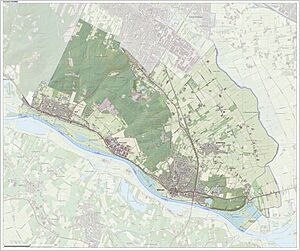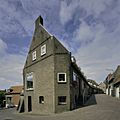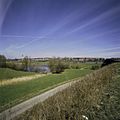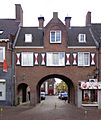Rhenen facts for kids
Quick facts for kids
Rhenen
|
|||
|---|---|---|---|
|
City and Municipality
|
|||
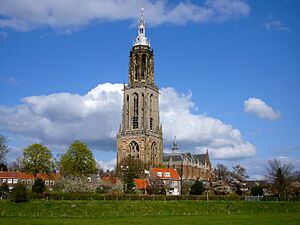
The Cunera Church in Rhenen
|
|||
|
|||
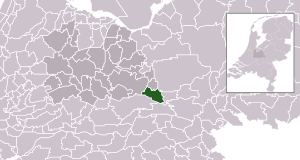
Location in Utrecht
|
|||
| Country | Netherlands | ||
| Province | Utrecht | ||
| Government | |||
| • Body | Municipal council | ||
| Area | |||
| • Municipality | 43.76 km2 (16.90 sq mi) | ||
| • Land | 42.08 km2 (16.25 sq mi) | ||
| • Water | Template:Dutch municipality water km2 km2 (Formatting error: invalid input when rounding sq mi) | ||
| Elevation | 43 m (141 ft) | ||
| Population
(May 2014)
|
|||
| • Municipality | 19,164 | ||
| • Density | 455/km2 (1,180/sq mi) | ||
| Demonym(s) | Rhenenaar | ||
| Time zone | UTC+1 (CET) | ||
| • Summer (DST) | UTC+2 (CEST) | ||
| Postcode |
3910–3922
|
||
| Area code | 0317, 0318 | ||
Rhenen is a city and a municipality (a type of local government area) in the central part of the Netherlands. It's pronounced something like "RAY-nen".
This municipality also includes the villages of Achterberg, Remmerden, Elst, and Laareind. Rhenen is in a special spot where the Utrecht Hill Ridge (a chain of hills) meets the Rhine river. This gives Rhenen a unique look with some hilly areas.
Right next to the city is the Grebbeberg, a hill that reaches about 50 meters (164 feet) high.
Contents
Rhenen's Past: A Look at History
Early Days: Before the 1900s
Rhenen became a city, meaning it got special rights, around 1256 to 1258. In 1346, the bishop of Utrecht ordered a defensive wall to be built around the city. This wall was important because Rhenen was close to the border with another area called Guelders.
Even though Rhenen used to collect money from ships passing on the Rhine river, it never had a big harbor. The three gates that were part of the city wall were taken down in 1840. You can still see small pieces of the old wall today.
The city is also known for the Cunera Church. Parts of this church were built way back in the 1400s. It holds the remains of Saint Cunera and used to attract many pilgrims (people who travel for religious reasons). A story says that Cunera was buried on a nearby hill, now called the Cuneraheuvel. The church's tall tower was built between 1492 and 1531.
Between 1630 and 1631, a palace called the Koningshuis was built in Rhenen. It was for Frederick V, who was a ruler who had lost his position. This palace was later taken down in 1812.
World War II: A Time of Damage and Rebuilding
During the German attack on the Netherlands in May 1940, parts of Rhenen's city center were destroyed. This was because Rhenen was near the Grebbelinie, a defensive line. Some rebuilding happened even during the war.
In 1945, the city was damaged again when the country was freed from German occupation. Many Dutch soldiers who died fighting the Germans near Rhenen are buried at the Erebegraafplaats (Cemetery of Honor). This cemetery is located on the Grebbeberg hill. Across the road, there is an important war monument with a poem by J.C. Bloem.
In 2008, Rhenen celebrated its 750th birthday!
Places to Visit in Rhenen
Rhenen has several interesting sights:
- Ouwehands Dierenpark: This is a popular zoo that first opened in 1932. You can see many different animals there, including white lions.
- The Cunera Church: This is a beautiful late-Gothic church built between 1492 and 1531.
- Modern Roman Catholic church: Called the Gedachteniskerk, it was built between 1958 and 1959.
- Building 'De Brakke': An old building from 1787.
- Ruins of the old city wall: You can still see parts of the 14th-century Medieval defensive wall.
- The Binnenmolen (Rhenen): A round gristmill (a mill for grinding grain) from 1893.
- The Prattenburg estate: A large property with a historic house.
- Military War Cemetery Grebbeberg: A military cemetery on the Grebbeberg hill.
Getting Around: Transport
Rhenen has its own train station, the Rhenen railway station, which makes it easy to travel to and from the city.
Famous People from Rhenen
Many interesting people have connections to Rhenen:
- Frederick V (1596–1632): He was a ruler who lived in Rhenen for a time.
- Giedo van der Garde (born 1985): A Dutch racing car driver.
- Madelein Meppelink (born 1989): A Dutch beach volleyball player who competed in the Olympics.
- Jacob Nienhuys (1836–1927): He started a tobacco company called Deli Company in Sumatra.
- Remy Reynierse (born 1961): A former football player and current coach.
- Bibiane Schoofs (born 1988): A Dutch professional tennis player.
- Jacobus Tollius (1633–1696): A Dutch expert in classical studies.
- Eelco Uri (born 1973): A Dutch former water polo player who competed in the Olympics.
- Lisa van Viegen (born 1978), also known as iET: A Dutch singer-songwriter.
- Nico Drost (born 1980): A Dutch Member of Parliament.
Images for kids
See also
 In Spanish: Rhenen para niños
In Spanish: Rhenen para niños




